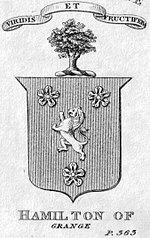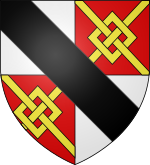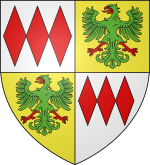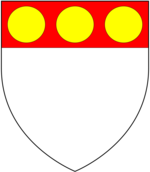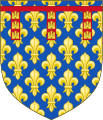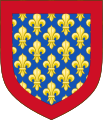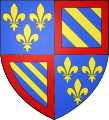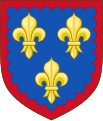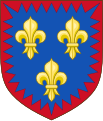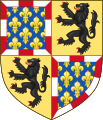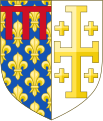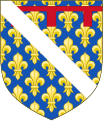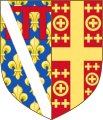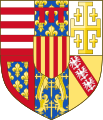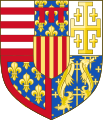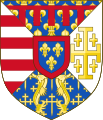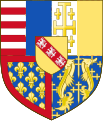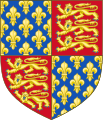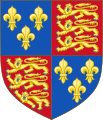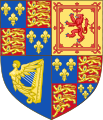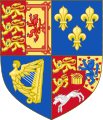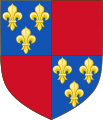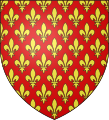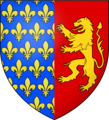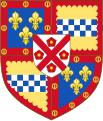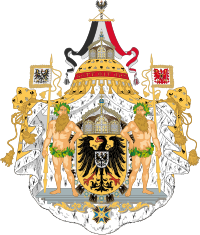User:JMvanDijk/Sandbox 9
House of David and the polity of Ancient Israel and Judah[edit]
Arms Box[edit]
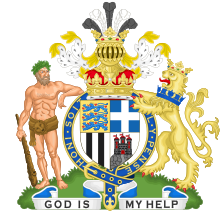
|
From 1947 to 1949: |
Hamilton[edit]
see Alexander Hamilton and Hamilton family
| Coat of arms of Hamilton of Grange | |
|---|---|
 | |
| Versions | |
 | |
| Shield | Gules, a lion rampant, argent, betwixt three cinquefoils, ermine |
- ^ a b Boutell's Heraldry. (1973) ISBN 0-7232-1708-4.
- ^ a b Pinches, J. H. & R. V., The Royal Heraldry of England, 1974, Heraldry Today.
- ^ "Duke of Edinburgh". 13 January 2009. Archived from the original on 2009-01-13. Retrieved 23 May 2018.
- ^ *Robertson, William (1889). Historical Tales and Legends of Ayrshire Vol.II. London: Hamilton, Adams & Co. p. Plate 6. OCLC 1741572.
- ^ "Rare Artifacts at Columbia's RBML". The Alexander Hamilton Awareness Society. The Alexander Hamilton Awareness Society. 2011. Retrieved 2016-06-20.
- ^ Robertson, William (1889). Historical Tales and Legends of Ayrshire, Vol. II. London: Hamilton, Adams & Co. p. Plate 6. OCLC 1741572.
- ^ Scholet, Nicole (2011). "Rare Artifacts at Columbia's RBML". The Alexander Hamilton Awareness Society.
Assumed Arms[edit]
The Spencers and The Despencers[edit]
The family is descended in the male line from Henry Spencer (died c. 1478). In the 16th century they claimed that Henry was a descendant of the cadet branch of the ancient House Le Despencer. The descent of the family from the Medieval Despencers has been debunked, especially by J. Horace Round in his essay The Rise of the Spencers. The Spencers were granted a coat of arms in 1504, "Azure a fess Ermine between 6 sea-mews’ heads erased Argent" which bears no resemblance to that used by the family after c. 1595, which was derived from the Despencer arms, "Quarterly Argent and Gules in the second and third quarters a Fret Or overall on a Bend Sable three Escallops of the first" (the scallops standing for the difference as a cadet branch). Round argued that the Despencer descent was fabricated by Richard Lee, a corrupt Clarencieux King of Arms.[1] Citing Round, The Complete Peerage dismissed the alleged Despencer descent as an "elaborate imposture" which "is now incapable of deceiving the most credulous."[2] [3] [4]
Montagus and Montagues/Montacute[edit]
Their ancestor was one Richard Ladde, grandfather of the Lord Chief Justice Sir Edward, who changed his name to Montagu in about 1447. His descendants claimed a connection with the older house of Montagu or Montacute, Barons Montagu or Montacute and Earls of Salisbury, but there is no sound evidence that the two families were related. A case has been made out for the possibility that the Ladde alias came from a division among coheirs about 1420 of the remaining small inheritance of a line of Montagus at Spratton and Little Creton, also in Northamptonshire (Sources:English Genealogy, Anthony Wagner).[5]
The Rozels of Bedford[edit]

The heraldic blazon for the coat of arms of the Russell dukedom is: Argent, a lion rampant gules; on a chief sable, three escallops of the first.
The arms show a claim to be descended from the medieval lord Hugh de Rozel, which has been debunked, especially by J. Horace Round in his essay The Rozels of Bedford". [6] [7] The family tree on the website of Woburn Abbey only refers to the descent from the provable Stephen Russell in 1394.[8]
The chief from these arms is present in the arms of the modern coat of arms of the London Borough of Camden, because the dukes of Bedford used to own land in the present borough.
- ^ Round, pp. 292–309
- ^ The Complete Peerage, vol. 4, p. 259. See also the Nov. 1902 edition of The Ancestor Quarterly, which described the Spencers as "that pushful house of shepherd kings" with a "brand new and more than doubtful pedigree." Sounding a more gentle tone, Don Steel in the March 1996 edition of Soul Search noted sadly that the pedigree forgery "obscures the real achievement of the Spencers of Althorpe. Alone, perhaps among the English nobility, the Spencers owed their riches and their rise not to the favour of a king or to the spoils of monasteries, nor even to a fortune made in trade, but to successful farming."
- ^ Round, J. Horace (1901). "The Spencers and The Despencers". The Baronage. The Baronage Press Ltd and Pegasus Associates Ltd. Retrieved 1 January 2017.
- ^ Round, J. Horace (1901). "The Spencer Family". The Baronage. The Baronage Press Ltd and Pegasus Associates Ltd. Retrieved 1 January 2017.
- ^ Wagner, Anthony (1960). English Genealogy. Oxford: Oxford University Press. ISBN 9780712667241.
The explanation of a fifteenth century yeoman's Norman name might sometimes be female descent from a knightly house through a coheir. The Montagus of Boughton, Northhamptonshire, who acquired a barony in 1621, an earldom in 1689, the dukedom of Montagu in 1705, and in their younger branches the earldom of Manchester in 1626, the dukedom of Manchester in 1719, and the earldom of Sandwich in 1660, descended from Richard Montagu alias Ladde, a yeoman or husbandman, living in 1471 at Hanging Houghton, Northamptonshire, where the Laddes had been tenants since the fourteenth century. Alias names, in some respect the forerunners of modern compound (or double-barreled) name, were common in the Middle Ages. In the earliest times, when surnames were new, an alias may just mean indecision between equally attractive alternatives. Later they sometimes indicate bastardy (one name perhaps being the father's and one the mother's), but in most cases probably mark inheritance through an heiress whose name was thus perpetuated. A good case has been made out for the possibility that the Ladde alias came from a division among coheirs about 1420 of the remaining small inheritance of a line of Montagus at Spratton and Little Creton, also in Northamptonshire. This line was of knightly origin and probably a branch of the baronial Montagus (Earls of Salisbury from 1337), whose almost certain ancestor Dru de Montagud was a tenant-in-chief in 1086. Other yeoman Montagus are found in Buckinghamshire from 1354 when Roger Montagu appears as a witness to a quitclaim of land in Great Kimble, notably in Halton where a family of Montagu alias Elot held land from about 1440 to 1610. A line of Montagus found in Waddesdon from about 1540 may have branched from these. These in the eighteenth century were shepherds and drovers and one set up in Aylesbury as a wheelwright and another as a tailor. Another line, also possibly branched from Halton, is found at Boveney and Dorney in the sixteenth and seventeenth centuries. This produced Richard Montagu, Bishop of Chichester (1628-38) and Norwich (1638-41), and Peter Montagu, who settled in Virginia.
- ^ Round, pp. 292–309
- ^ Round, J. Horace (1999). "The Rozels of Bedford". The Baronage. The Baronage Press Ltd and Pegasus Associates Ltd. Retrieved 1 January 2017.
- ^ "Family Tree of the Russells". The Woburn Estate. Woburn Enterprises. 2014. Retrieved 8 February 2017.
France[edit]
The succession in 1328[edit]
King Charles IV is no longer. He has no male descendants. He is the youngest son of Philip the Fair. The situation in 1328 is unlike that of 1316. In 1316, a king's son was competing with a brother and a younger child. In 1328, Philip of Valois is not the closest in the line, or the more direct, because the last Capetians girls left now have husbands. But the Count of Valois was the closest male relative in the male line, and he is 35 years old. He is the eldest male of the family.
| The French royal family in 1328 | |||||||||||||||||||||||||||||||||||||||||||||||||||||||||||||||||||||||||||||||||||||||||||||||||||||||||||||||||||||||||||||||||||||||||||||||||||||||||||||||||||||||||||||||||||||||||||||||||||||||||||||||||||||||||||||||||||||||||||||||||||||||||||||||||||||||||||||||||||||||||||||||||||||||||||||||||||||||||||||||||||||||||||||||||||||||||||||||||||||||||||||||||||||||||||||||||||||||||||||||||||||||||||||||||||||||||||||||||||||||||||||||||||||||||||||||||||||||||||||||||||||||||||||||||||||||||||||||||||||||||||||||||||||||||||||
|---|---|---|---|---|---|---|---|---|---|---|---|---|---|---|---|---|---|---|---|---|---|---|---|---|---|---|---|---|---|---|---|---|---|---|---|---|---|---|---|---|---|---|---|---|---|---|---|---|---|---|---|---|---|---|---|---|---|---|---|---|---|---|---|---|---|---|---|---|---|---|---|---|---|---|---|---|---|---|---|---|---|---|---|---|---|---|---|---|---|---|---|---|---|---|---|---|---|---|---|---|---|---|---|---|---|---|---|---|---|---|---|---|---|---|---|---|---|---|---|---|---|---|---|---|---|---|---|---|---|---|---|---|---|---|---|---|---|---|---|---|---|---|---|---|---|---|---|---|---|---|---|---|---|---|---|---|---|---|---|---|---|---|---|---|---|---|---|---|---|---|---|---|---|---|---|---|---|---|---|---|---|---|---|---|---|---|---|---|---|---|---|---|---|---|---|---|---|---|---|---|---|---|---|---|---|---|---|---|---|---|---|---|---|---|---|---|---|---|---|---|---|---|---|---|---|---|---|---|---|---|---|---|---|---|---|---|---|---|---|---|---|---|---|---|---|---|---|---|---|---|---|---|---|---|---|---|---|---|---|---|---|---|---|---|---|---|---|---|---|---|---|---|---|---|---|---|---|---|---|---|---|---|---|---|---|---|---|---|---|---|---|---|---|---|---|---|---|---|---|---|---|---|---|---|---|---|---|---|---|---|---|---|---|---|---|---|---|---|---|---|---|---|---|---|---|---|---|---|---|---|---|---|---|---|---|---|---|---|---|---|---|---|---|---|---|---|---|---|---|---|---|---|---|---|---|---|---|---|---|---|---|---|---|---|---|---|---|---|---|---|---|---|---|---|---|---|---|---|---|---|---|---|---|---|---|---|---|---|---|---|---|---|---|---|---|---|---|---|---|---|---|---|---|---|---|---|---|---|---|---|---|---|---|---|---|---|---|---|---|---|---|---|---|---|---|---|---|---|---|---|---|---|---|---|---|---|---|---|---|---|---|---|---|---|---|---|---|---|---|---|---|---|---|---|---|---|---|---|---|---|---|---|---|---|---|---|---|---|---|---|---|---|---|---|---|---|---|---|---|---|---|---|---|---|---|---|---|---|---|---|---|---|---|---|---|---|---|---|---|---|---|---|---|---|---|---|---|---|---|---|---|---|---|---|---|---|---|---|---|---|---|---|---|---|---|---|---|---|---|---|---|---|---|---|---|---|---|---|---|---|---|
| |||||||||||||||||||||||||||||||||||||||||||||||||||||||||||||||||||||||||||||||||||||||||||||||||||||||||||||||||||||||||||||||||||||||||||||||||||||||||||||||||||||||||||||||||||||||||||||||||||||||||||||||||||||||||||||||||||||||||||||||||||||||||||||||||||||||||||||||||||||||||||||||||||||||||||||||||||||||||||||||||||||||||||||||||||||||||||||||||||||||||||||||||||||||||||||||||||||||||||||||||||||||||||||||||||||||||||||||||||||||||||||||||||||||||||||||||||||||||||||||||||||||||||||||||||||||||||||||||||||||||||||||||||||||||||||
| Notes:
| |||||||||||||||||||||||||||||||||||||||||||||||||||||||||||||||||||||||||||||||||||||||||||||||||||||||||||||||||||||||||||||||||||||||||||||||||||||||||||||||||||||||||||||||||||||||||||||||||||||||||||||||||||||||||||||||||||||||||||||||||||||||||||||||||||||||||||||||||||||||||||||||||||||||||||||||||||||||||||||||||||||||||||||||||||||||||||||||||||||||||||||||||||||||||||||||||||||||||||||||||||||||||||||||||||||||||||||||||||||||||||||||||||||||||||||||||||||||||||||||||||||||||||||||||||||||||||||||||||||||||||||||||||||||||||||
Heraldic Tree of the 3rd Dynasty of France[edit]
Augmentations on Other Basics[edit]
The most basic marks of difference used by the Capetians were the label, bordure and bend. Charges and variations were added by cadets with the expansion of the dynasty. The cross and saltire were used as marks of distinction by the spiritual peers of France.
-
Label gules
(Capetian House of Anjou) -
Counts of Artois
label gules, on eachpoint three castles or -
Bend gules
(House of Bourbon) -
Bend compony argent and gules
(House of Evreux) -
Blason Philippe de France (1336-1375) as count of Poitiers, later Philip V le Long
Label compony argent and gules -
Bordure compony argent and gules
(House of Valois-Burgundy)
Under the House of Bourbon the bend gules gradually evolved into a baton couped, while the label argent and bordure gules were associated with the dukes of Orleans and Anjou, respectively.
-
Baton couped gules with bezant in upper left of baton, Louis Ier prince de Condé (1530 † 1569).svg
-
Baton couped gules
(Princes of Condé) -
Princes of Conti
-
Louis, Duke of Burgundy eldest son Louis le Grand Dauphin and later le petit Dauphin
-
Louis, Duke of Brittany (1707–1712) great grandson of Louis XIV of France
-
Label argent
(Dukes of Orleans) -
Charles, duke of Berry
-
Louis, duke of Bretagne
-
Louis, count of Provence, later Louis XVIII of France
-
Charles, count of Artois, later Charles X of France
-
César, duke of Vendôme
-
Other royal bastards
-
Michel d'Orléans, count of Évreux
see [1]
Issue of Philippe the Bold, duke of Burgundy[edit]
-
Philippe the Bold, count of Touraine
-
Philippe the Bold, duke of Burgundy
-
Jean the Fearless, duke of Burgundy
-
Philippe the Good, duke of Burgundy
-
Charle the Bold, count of Charolais
-
Antoine, duke of Brabant
-
Philippe, count of Saint Pol
-
Philippe, count of Nevers
-
Corneille,seigneur de Beveren et Vlissingen and Antoine the Grand Bastard
-
Antoine the Grand Bastard, seigneur de Beveren et Vlissingen, comte de La Roche
-
Philippe de Bourgogne-Beveren, son of Antoine, bâtard de Bourgogne, seigneur de Beveren, Vlissingen et Veere , comte de La Roche
-
Adolphe de Bourgogne-Beveren, son of Philippe de Bourgogne-Beveren, seigneur de Beveren, Vlissingen et Veere , comte de La Roche & his son, Maximilien seigneur de Beveren, Marquis de Vlissingen et Veere , comte de La Roche, amiral de Pays-Bas
Royal house of Anjou-Sicile[edit]
First line (issue of Charles of France, count of Anjou)[edit]
-
Charles, count of Anjou
-
Charles, count of Anjou and Provence, king of Sicily
-
Charles Martel, king of Hungary
-
Charles Robert, king of Hungary
-
Clémence, queen of France
-
André, duke of Calabre
-
Charles, duke of Calabre
-
Philippe, prince of Tarente
-
Robert and Philippe II, princes of Tarente, titular emperors of Constantinople
-
Raymond-Béranger, count of Andria
-
Jean, Charles and Louis, dukes of Durazzo
-
Jeanne II, queen regnant of Sicily
-
Jeanne II, queen regnant of Sicily, countess consort of la Marche
-
Jacques II, count of La Marche, consort to Jeanne II
Second line (issue of Louis of Valois, duke of Anjou)[edit]
-
Louis I, duke of Anjou, adopted by Jeanne I of Sicily
-
Louis II and Louis III (adopted by Jeanne II), dukes of Anjou, kings of Sicily
-
Marie, queen of France (elder daughter of Louis II)
-
René, duke of Bar and Lorraine
-
René, duke of Anjou, Bar and Lorraine, king of Sicily
-
René, duke of Anjou, Bar and Lorraine, king of Sicily and Aragon
-
René, duke of Anjou and Bar, king of Sicily and Aragon
-
René, duke of Anjou and Bar, king of Sicily
-
Yolande, duchess of Bretagne (younger daughter of Louis II)
-
Charles IV, count of Maine (younger son of Louis II)
-
Charles V, count of Maine and Provence, king of Sicily
-
Jean II and Nicolas, dukes of Lorraine and Calabre, son and grandson of René of Anjou
-
Yolande, duchess of Lorraine and Calabre, daughter of René of Anjou
-
Marguerite, queen of England, younger daughter of René of Anjou
Successors to the second house of Anjou-Sicile[edit]
-
René II of Lorraine, duke of Lorraine and Calabre, son of Yolande
-
Claude of Lorraine, duke of Guise, second son of René II of Lorraine
-
Charles VIII of France, heir general of Charles V of Maine (arms for Naples)
-
Louis XII of France, heir general of Charles VIII (arms for Naples)
-
Ferinando, illegitimate son of Alfonso V de Aragón, conqueror of Naples in 1442
-
Fernando II de Aragón, conqueror of Naples in 1504
Claims on the French Crown using the Arms of France[edit]
-
^ The arms of the Kings of England from 1340 to c.1411, quartering France ancienne. The French arms are quartered as arms of pretence and in precedence (1st & 4th) to the paternal Plantagenet arms as a statement in recognition of the quasi-feudal superiority of the royal French arms to the arms of Plantagenet
-
Royal Arms of England (1399-1603)
-
Royal Arms of England under Henry VI of England (1422-1471)
-
Royal Arms of England (1603-1707)
-
Royal Arms of Great Britain (1707-1714)
-
Royal Arms of Great Britain (1714-1801), after which the claim to the throne of France was dropped.
Augementations of Honor Using the Royal Arms of France[edit]
-
Arms of d'Albret from Coat of arms of Charles dAlbret. In 1389 Charles d'Albret, comte de Dreux, was allowed by his maternal cousin the king Charles VI in 1389 to quarter his arms (Gules plain) with those of France (see Heraldica, Azure 3 Fleurs-de-Lis Or, Augmentations of Honor). The lineage became extinct in 1676.
-
Augmented Arms of Medici: the arms of the famous Medici family were or six balls gules when Louis XI of France allowed them to change the ball in chief to azure three fleurs-de-lis or. The lineage became extinct with the last grand-duke of Tuscany in 1737. (see Heraldica, Azure 3 Fleurs-de-Lis Or, Augmentations of Honor)
-
Armes of the Châteaubriant Family, concession of Saint Louis "Notre sang teint les bannières de France". In reality, there is no objective proof for the statement.
-
Arms of the Thouars Family. The reverse of the arms of France.
-
Blason fr fam Tournon: (Dauphiné): per pale France ancient and gules a lion passant or. This family is mentioned in the 11th century and has a continuous line of descent since the 14th c. The origin of the France ancient coat is unknown, and it was assumed that it was a royal grant. The main line died in 1644, the Tournon-Simiane branch died in 1912. (see Heraldica, Azure 3 Fleurs-de-Lis Or, Augmentations of Honor)
-
Ferrara (Italy): France, a bordure indented or and gules. See the arms of Este from the villa d'Este, Tivoli). Granted by Charles VI to Nicola d'Este, duke of Ferrara. (see Heraldica, Azure 3 Fleurs-de-Lis Or, Augmentations of Honor)
-
Esmé Stuart (1542-1583) 1er Duc de Lennox
-
Stuart of Darnley, seigneur d'Aubigny: was authorized by Charles VII in 1428 to add a quarter of France to his arms. The family settled in France, later returned to Scotland, and became extinct in 1672. In the 16th c., a bordure gules with buckles or was added to the quarter of France. (see Heraldica, Azure 3 Fleurs-de-Lis Or, Augmentations of Honor)
Coat of Arms of German Empire[edit]
Elector for Holy Roman Emperor[edit]
House of Hohenzollern[edit]
Habsburgs[edit]
Family name Habsburg[edit]
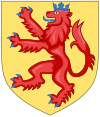
Most royal families did not have a family name until the 19th century. They were known as "of" (in German von) based on the main territory they ruled. For example, sons, daughters, grandsons and granddaughters of a ruling French King were known as "of France" (see Wikipedia on House of Bourbon). The name "Capet" was an invention of the French Revolutionaries. "Bourbon" was in some sense the name of the house as it was differentiated from the previous Valois kings. Princes and Princesses of the royal house of England were known as "of England", or later "Great Britain" (see House of Windsor) or "of" the main title associated with their parent (see Prince William of Wales). In the Middle Ages, princes of England were often known by the town or castle of their birth (see John of Gaunt, Henry Bolingbroke, or Henry of Monmouth). Even when the royal family had a last name (see House of Tudor, House of Stuart or House of Windsor), it was not used in their titles.
Similarly, the Habsburg name was used as one of the subsidiary titles of the rulers above, as in "Princely Count of Habsburg" (see above under Habsburg-Lorraine). The Habsburg arms (see above) were displayed only in the most complete (great arms) of the prince. The dynasty was known as the "house of Austria". Most of the princes above were known as Archduke xyz "of Austria" and had no need of a surname. Charles V was known in his youth after his birthplace as "Charles of Ghent". When he became king of the Spains he was known as "Charles of Spain", until he became emperor, when he was known as Charles V ("Charles Quint"). In Spain, the dynasty was known as the "casa de Austria", and illegitimate sons were given the title of "de Austria" (see Don Juan de Austria and Don Juan José de Austria). The arms displayed in their simplest form were those of Austria, which the Habsburgs had made their own, at times impaled with the arms of the Duchy of Burgundy (ancient).
 |
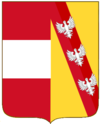 |
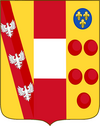 |
 |
|---|---|---|---|

When Maria Theresa married the duke of Lorraine, Francis Stephen (see above), there was a desire to show that the ruling dynasty continued as did all its inherited rights, as the ruling dynasty's right to rule was based on inherited legitimate birthright in each of the constituent territories. Using the concept of "Habsburg" as the traditional Austrian ruler was one of those ways. When Francis I became Emperor of Austria, there was an even further reinforcement of this by the reappearance of the arms of Habsburg in the tripart personal arms of the house with Austria and Lorraine. This also reinforced the "Germaness" of the Austrian Emperor and his claim to rule in Germany against the Prussian Kings, or at least to be included in "Germany". As Emperor Francis Joseph wrote to Napoleon III „Nein, ich bin ein deutscher Fürst“ [1] In the genealogical table above, some younger sons who had no prospects of the throne, were given the personal title of "count of Habsburg".
Today, as the dynasty is no longer on the throne, the surname of members of the house is taken to be "von Habsburg" or more completely "von Habsburg-Lothringen" (see Otto von Habsburg and Karl von Habsburg). Princes and members of the house use the Tripartite arms shown above, generally forgoing any imperial pretentions.
House of Habsburg[edit]
House of Habsburg Family Trees[edit]
House of Wittelsbach[edit]
House of Anscarids, Counts of Burgundy, Counts of Châlons-Arlay[edit]
Spain & the House of Trastámara[edit]

House of Luxemburg/Luxemburg Details[edit]
The House of Luxemburg/Luxembourg stemmed from the House of Ardenne (or Ardennes, French Maison d'Ardenne) was an important medieval noble family from Lotharingia, known from at least the tenth century. They had several important branches, descended from several brothers:[2]
- The House of Ardenne-Luxembourg, descended from Count Sigfried.
- The House of Ardenne-Verdun, with several Dukes of Lower Lotharingia, descended from Count Gozelin.
- The House of Ardenne-Bar, with several Dukes of Upper Lotharingia, descended from Frederick I, Duke of Upper Lorraine.
When the male line died. Three houses descended from the women of the counts of Luxembourg, the Counts of Loon, the Counts of Grandpré, and the Dukes of Limburg. All three families had a place in relation to the succession of the House of Ardennes. Indeed, the Count of Grandpré was the next heir of Conrad II of Luxembourg, who was the last representative of the Ardennes dynasty. But, Emperor Frederick Barbarossa preferred that Luxembourg was held by a lord Germanic rather than French and attributed the county to Henry of Limburg-Arlon (see below), son of Conrad's aunt Ermesinde and Count Godfrey I of Namur. The Counts of Loon are also in position to claim the inheritance Luxembourg, albeit weaker position.
Having succeeded to the county of Luxemburg, the younger branch of the House of Limburg-Arlon is the family that succeeded in getting one of its scions elected Holy Roman Emperor. From there descended the Kings of Bohemia, several other Emperors and a King of Hungary as shown below.
Egmond[edit]
House of Limburg-Styrum[edit]
Welf[edit]
Oldenborg and Glucksborg[edit]
Sweden[edit]
House of Medici[edit]
Descendants of Ragnar Lodbrok[edit]
Descendants of the Japanese Imperial Family[edit]
The Inca Dynasty[edit]
Greek Mythology[edit]
Safavid Claimed Descent[edit]
Fictional -- Dune[edit]
- ^ 1: Wolfgang Menzel: Die letzten 120 Jahre der Weltgeschichte, Band 6 (1740-1860), Adolph Krabbe, Stuttgart 1860, S. 211 Online, p. 211, at Google Books
2.: Wolfgang Menzel: Supplementband zu der Geschichte der letzten 40 Jahre (1816-1856). Adolph Krabbe, Stuttgart 1860, S. 153 Online, p. 153, at Google Books
Aus diesem wurde später: „Sire, ich bin ein deutscher Fürst“:
Hermann Struschka: Kaiser Franz Josef I. Georg Szelinski, Wien 1888, S. 22 Online, p. 22, at Google Books
Es kommt auch in der anglifizierten Schreibung „Sir, ich bin deutscher Fürst“ vor.
Stenographische Protokolle – Abgeordnetenhaus – Sitzungsprotokolle. Haus der Abgeordneten – 14. Sitzung der XVIII. Session am 16. Juli 1907, S. 1337 alex.onb.ac.at 3: wikiquote:de:Franz Joseph I. von Österreich - ^ Parisse, ‘Généalogie de la Maison d'Ardenne’, La maison d'Ardenne Xe-XIe siècles. Actes des Journées Lotharingiennes, 24 - 26 oct. 1980, Centre Univ., Luxembourg, (1981) 9-41


